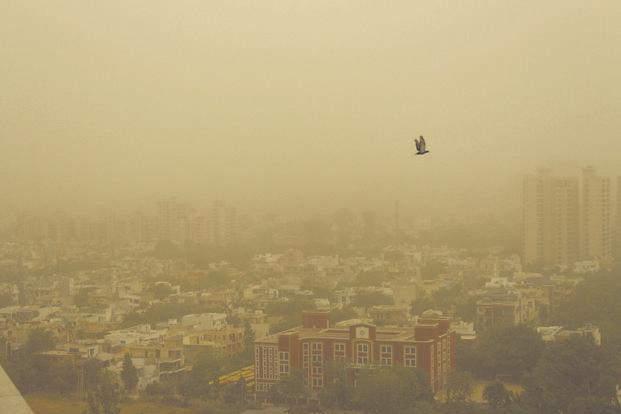Despite the peak summer, there is no improvement in air pollution levels in Delhi. It is almost as bad as they are in winter, highlighting the Capital’s enduring bad-air problem.
On Monday, the air quality was in the “very poor” category, fomented by westerly winds bringing dust from neighbouring states, stubble burning in parts of Punjab and Haryana, and forest fires in Uttarakhand. There have been four “very poor” air quality days in the past week and the average PM 2.5 (fine, respirable pollution particles) concentrations often crossed 250µg/m3, four times the national safety standard.
According to data collated by Delhi-based environmental communications initiative, from the Central Pollution Control Board (CPCB), PM 2.5 concentrations have even crossed 500µg/m3 at Anand Vihar, Bawana, and Rohini.
The IMD (India Meteorological Department) recorded heavy showers in parts of the national capital on Monday night, bringing some relief from the scorching heat and the rising pollution, with the Air Quality Index (AQI) coming down slightly from 322 at 4 pm to 311 at 11 pm.
The AQI is calculated on a scale of 0-500 with a 0-50 score considered “good”, 51-100 “satisfactory”, 101-200 “moderate”, 201-300 “poor”, 301-400 “very poor” and 401-500 “severe”.
However, environment scientists said this slight drop in the pollution could be temporary as it was due to the rain, and the pollution will remain in the “poor” or “very poor” category at least till May 16 due to the recurrent dust storms.
As per the CPCB data, Ghaziabad was the most polluted city in the country on Monday, with an Air Quality Index (AQI) of 384. Neighbouring Noida was the second most polluted city with an AQI value of 347.
Officials from East Municipal Corporation, New Delhi Municipal Council and public works department said they have been sprinkling water, covering construction sites, mechanically sweeping roads regularly to combat dust pollution, but pollution levels don’t reflect these actions.
Poor air quality in Delhi has been aggravated by westerly winds bringing dust from neighbouring Rajasthan and Haryana and below-normal pre-monsoon showers in northwestern India, leading to extremely dry and dusty conditions.
According to data released by the India Meteorological Department (IMD), pre-monsoon rainfall between March 1 to May 8 over northwest India is 37% below the long-period average.
The task force recommended that agencies intensify efforts to control dust from various sources such as construction and demolition sites, handling of construction material waste, roads, stone crushers, and ready-mix concrete plants.
The task force also advised the public to minimise prolonged exposure to high air pollution levels outdoors. VK Shukla, head of CPCB’s air quality lab in Delhi said, “GRAP is already being implemented. The main source for a spike in dust which is being transported from nearby areas and even generated locally. The weather conditions are ideal for re-suspension.”
The air quality could improve in the next few days, although IMD’s bulletin on Monday said dust-raising winds are likely over north India till Tuesday evening.
BP Yadav, head of IMD’s regional meteorological centre, said, “There is heating and strong westerly to southwesterly winds, bringing dust from Rajasthan and adjoining areas. I think the fires in Uttarakhand and Haryana will have a localised impact. They may only have a minor impact in Delhi. We are expecting thundershowers in the next three to four days, and the dust particles are likely to settle down after that.”

Leave a Reply